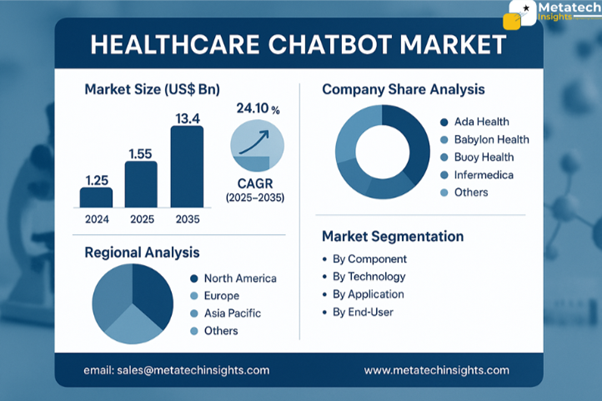Healthcare Chatbot Market to Hit USD 13.4 billion by 2035 | CAGR 24.10%
08 Aug 2025 | Report ID: MI3278 | Industry: Consumer Goods | Pages: 218 | Forecast Year: 2025-2035

Read more about this report- Healthcare Chatbot Market to Hit USD 13.4 billion by 2035 | CAGR 24.10%
The Healthcare Chatbots Market will achieve USD 13.4 billion by 2035 through a projected 24.10%CAGR from 2025 to 2035.
The Healthcare Chatbots Market is expanding at a quick pace, and healthcare facilities are adopting an artificial intelligence approach to patient engagement, triage, and support. The main driving forces are the growing chronic diseases, shortage of healthcare workforce, and the desire for 24/7 access. These chatbots are useful in relieving the clinical burden and also provide a timely, personalized mode of communication. Their use in virtual care models has also sped up across the world as a result of post-pandemic digitalization.
The market is classified into software and services according to component. Originally, software was the dominant force, since it could be scaled on a wide variety of healthcare platforms, though the increasing demand for services based on integration, customization, and updates is growing rapidly. More providers of services offer chatbot development that could implement EHR integration, compliance, and analytics. This makes the work process much smoother and improves provider-patient communication.
Under Technology, some critical areas comprise Natural Language Processing (NLP), Machine Learning (ML), and Automated Speech Recognition (ASR). NLP is always in the lead because of its key position in the processing of user queries and providing them with precise answers. Chatbots can learn on their own and be voice-interacted with, which is improved by ML and ASR technologies. They provide more clinically relevant and human-like conversations as applied to these tools.
Application In the chatbot market, because it is one of the most popular markets in the world, there exist regions within it in symptom checking, appointment scheduling, mental health support, medication guidance, and insurance/billing queries. The symptom checkers are in their dominant use and help patients conduct self-checks and do not visit where not needed. The number of chatbots based on mental health is growing rapidly as a result of the increase in the number of cases related to anxiety and stress. Billing bots and medication reminders help to comply with care and decrease the administrative load.
The Hospitals & Clinics, Insurance Providers, Pharmacies, and Patients (Direct-to-Consumer) are the major segments under End User. Hospitals are those that use it principally, as they automate pre-visit intake, triage, and follow-ups on discharge. Chatbots are also adopted by the insurers to make inquiries about claims and direct through policies. In the meantime, pharmacist rooms and consumer health applications take advantage of bots to provide personalized guidance and adherence options.
Key growth drivers are escalating healthcare expenditures, the proliferation of smartphone users, and the mounting popularity of the concept of digital health. The increased necessity of virtual helpers on a larger scale became clear in connection with COVID-19, which provoked the reduced reliance on in-person communication and required even stronger emphasis on virtual ones. Chatbots today can provide multilingual support, instant responses, and data privacy, thus being appealing to both the patients and the providers. Artificial intelligence further upgrades and the presence of regulation enhances the traction of the market.
North America is ahead of the world because of its high health-tech infrastructure, AI investment, and supportive regulations. Europe is next in terms of increasing uptake of national healthcare systems. Nevertheless, the fastest rate is observed in Asia Pacific, which is characterized by mobile-first populations, AI startups, and the embrace of herbal and tech wellness. Nations such as India, Singapore, and China are emerging as health AI innovation clusters.
Among the most popular ones are Ada Health, Babylon Health, Buoy Health, and Infermedica. These players couple clinical intelligence and a user-friendly interface to drive secure and real-time digital care. They remain ahead through strategic partnerships, personal health bots, and effective research and development pipelines. They also do this by widening internationally by partnering with insurers and hospitals, as well as consumer platforms.
Maximize your value and knowledge with our 5 Reports-in-1 Bundle - over 40% off!
Our analysts are ready to help you immediately.
